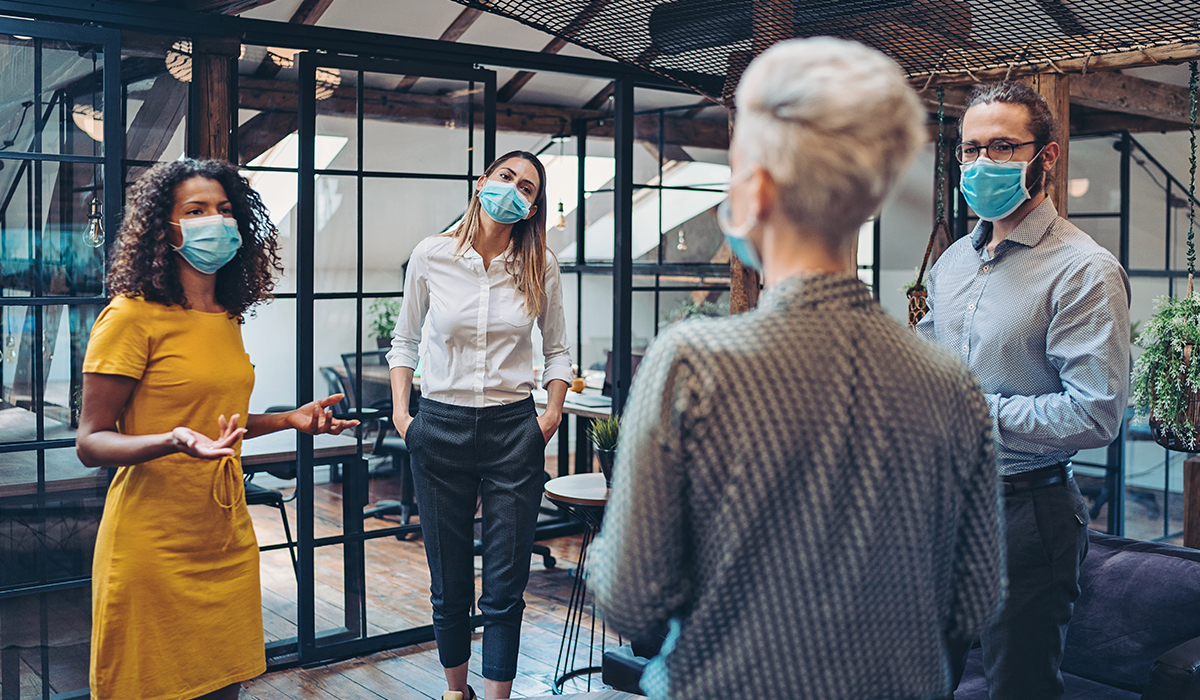Government advice is now for people to work from home if it’s possible to do so. It has been the norm for many staff to stay away from the office since March, when businesses were forced to make rapid decisions about a shift to remote working. As the pandemic spread at speed, compliance with the law and the safety of employees was paramount, and business continuity plans were formulated almost on a day-to-day basis.
In fact, home working has become so much part of the ‘new norm’ that even before the threat of a second wave loomed large, 50 big employers surveyed by the BBC in August said they had no plans to return their staff to the office until at least the new year. But many business leaders and their employees are eager to get back as soon as conditions allow, craving face-to-face collaboration with colleagues and clients, the separation of work and home, and even that Pret-a-Manger baguette.
Business as usual?
When you are able to open up the office again, the safety of staff will be the top priority and it will be vital that businesses make their workplaces Covid-secure. The Chartered Institute of Personnel Development (CIPD) offers comprehensive guidance on the steps business leaders should take to make their workplaces safe, and the advantages and disadvantages of a full return to the office, continuing with remote working, and the stages in between. It urges businesses to consider three key questions before bringing people back into the office: is it essential, is it sufficiently safe, and is it mutually agreed?
“The response businesses will get from their staff will vary,” notes Lianne Lambert, MD of human resources consultancy Lighter HR. “It will depend on how they have been finding home working and what their personal experience of Covid has been. Some people have been hit quite hard, perhaps they’ve lost a relative or been particularly ill themselves. And they’re going to be more fearful of returning to an office than others, who might be quite blasé about the whole thing. You need to engage with your staff and understand how they’re feeling and what reaction you’re likely to get when you ask them to return.”
One business that successfully brought all its 35 staff members back to work after the initial lockdown was eased is London-based design agency Blacksheep, which undertook a three-phase return beginning in July. The Entrepreneur Club spoke to them before the latest Government advice on home working.
“One thing I didn’t understand when we entered lockdown was the issues working from home presented for some people,” says founder Tim Mutton. “The average age here is around 27 and as much as they live very close to the studio, they might be in a bed-sit that’s not even big enough to get a desk in. We were telling people they could take their computers home and they said, ‘You don’t understand. All I’ve got is a bed.’ I had a massive epiphany at that point: they absolutely love the studio because it offers them more than they have at home. They’ve got the internet, a desk, a kitchen, somewhere where they can sit and eat. I empathise more with our people and understand their circumstances a lot better now than I did before.”
Listen and learn
However, some businesses may have a different experience. Even once risk assessments have been carried out and your business premises made Covid-safe, some staff might be reluctant to come back.
“First, you will need to understand their reasons,” says Lianne. “Have a look at their contract and see if they’re contractually obliged to return. If they refuse, you can go down the disciplinary route. But that should be a last resort. What we've seen is there may be quite a lot of push-back initially, but once you begin bringing people back and they see that the workplace is safe, they feel differently.”
Tim foresaw one significant barrier to business as usual: the limited availability of Covid testing.
“In all the time we’ve been back in, we had one case of someone who tested positive for Covid in the studio. That was something I had to manage – I knew the risk was there. Luckily at that point we were able to get everyone tested, and they all came back negative. If it happened now, we’d have a different issue, because the test stations aren’t available,” he says, citing their only staff member who hasn’t been able to get back into the office because a relative has contracted Covid and she has been unable to obtain a test.
Lianne agrees that a Covid-positive team member shouldn’t be every manager’s worst nightmare. “We have had a couple of clients go into a flat spin at that point, shut the office and send everybody home. By doing that, what you’re in effect saying is that you have not provided people with a Covid-secure workplace. The idea is to make the workplace safe if someone comes in with Covid, not only as long as no one does,” she says.
Creating a safe workplace
The Government offers some key advice on making your workplace Covid-secure, including:
- Complete a Covid-19 risk assessment and share it with staff.
- Clean more often and ask staff and visitors to use hand sanitiser.
- Ask visitors to wear face coverings.
- Make sure everyone is social distancing. Make it easy by putting up signs or introducing a one-way system.
- Increase ventilation by keeping doors and windows open and running ventilation systems.
- Turn people with coronavirus symptoms away.
In addition, workspaces should be arranged to keep people apart, the number of face-to-face meetings should be reduced, you should consider booking systems for desks and rooms to avoid overcrowding, and make sure that all staff and visitors are kept up to date with your safety measures.
Government advice is now for people to work from home if it’s possible to do so. It has been the norm for many staff to stay away from the office since March, when businesses were forced to make rapid decisions about a shift to remote working. As the pandemic spread at speed, compliance with the law and the safety of employees was paramount, and business continuity plans were formulated almost on a day-to-day basis.
In fact, home working has become so much part of the ‘new norm’ that even before the threat of a second wave loomed large, 50 big employers surveyed by the BBC in August said they had no plans to return their staff to the office until at least the new year. But many business leaders and their employees are eager to get back as soon as conditions allow, craving face-to-face collaboration with colleagues and clients, the separation of work and home, and even that Pret-a-Manger baguette.
Business as usual?
When you are able to open up the office again, the safety of staff will be the top priority and it will be vital that businesses make their workplaces Covid-secure. The Chartered Institute of Personnel Development (CIPD) offers comprehensive guidance on the steps business leaders should take to make their workplaces safe, and the advantages and disadvantages of a full return to the office, continuing with remote working, and the stages in between. It urges businesses to consider three key questions before bringing people back into the office: is it essential, is it sufficiently safe, and is it mutually agreed?
“The response businesses will get from their staff will vary,” notes Lianne Lambert, MD of human resources consultancy Lighter HR. “It will depend on how they have been finding home working and what their personal experience of Covid has been. Some people have been hit quite hard, perhaps they’ve lost a relative or been particularly ill themselves. And they’re going to be more fearful of returning to an office than others, who might be quite blasé about the whole thing. You need to engage with your staff and understand how they’re feeling and what reaction you’re likely to get when you ask them to return.”
One business that successfully brought all its 35 staff members back to work after the initial lockdown was eased is London-based design agency Blacksheep, which undertook a three-phase return beginning in July. The Entrepreneur Club spoke to them before the latest Government advice on home working.
“One thing I didn’t understand when we entered lockdown was the issues working from home presented for some people,” says founder Tim Mutton. “The average age here is around 27 and as much as they live very close to the studio, they might be in a bed-sit that’s not even big enough to get a desk in. We were telling people they could take their computers home and they said, ‘You don’t understand. All I’ve got is a bed.’ I had a massive epiphany at that point: they absolutely love the studio because it offers them more than they have at home. They’ve got the internet, a desk, a kitchen, somewhere where they can sit and eat. I empathise more with our people and understand their circumstances a lot better now than I did before.”
Listen and learn
However, some businesses may have a different experience. Even once risk assessments have been carried out and your business premises made Covid-safe, some staff might be reluctant to come back.
“First, you will need to understand their reasons,” says Lianne. “Have a look at their contract and see if they’re contractually obliged to return. If they refuse, you can go down the disciplinary route. But that should be a last resort. What we've seen is there may be quite a lot of push-back initially, but once you begin bringing people back and they see that the workplace is safe, they feel differently.”
Tim foresaw one significant barrier to business as usual: the limited availability of Covid testing.
“In all the time we’ve been back in, we had one case of someone who tested positive for Covid in the studio. That was something I had to manage – I knew the risk was there. Luckily at that point we were able to get everyone tested, and they all came back negative. If it happened now, we’d have a different issue, because the test stations aren’t available,” he says, citing their only staff member who hasn’t been able to get back into the office because a relative has contracted Covid and she has been unable to obtain a test.
Lianne agrees that a Covid-positive team member shouldn’t be every manager’s worst nightmare. “We have had a couple of clients go into a flat spin at that point, shut the office and send everybody home. By doing that, what you’re in effect saying is that you have not provided people with a Covid-secure workplace. The idea is to make the workplace safe if someone comes in with Covid, not only as long as no one does,” she says.
Creating a safe workplace
The Government offers some key advice on making your workplace Covid-secure, including:
- Complete a Covid-19 risk assessment and share it with staff.
- Clean more often and ask staff and visitors to use hand sanitiser.
- Ask visitors to wear face coverings.
- Make sure everyone is social distancing. Make it easy by putting up signs or introducing a one-way system.
- Increase ventilation by keeping doors and windows open and running ventilation systems.
- Turn people with coronavirus symptoms away.
In addition, workspaces should be arranged to keep people apart, the number of face-to-face meetings should be reduced, you should consider booking systems for desks and rooms to avoid overcrowding, and make sure that all staff and visitors are kept up to date with your safety measures.
Government advice is now for people to work from home if it’s possible to do so. It has been the norm for many staff to stay away from the office since March, when businesses were forced to make rapid decisions about a shift to remote working. As the pandemic spread at speed, compliance with the law and the safety of employees was paramount, and business continuity plans were formulated almost on a day-to-day basis.
In fact, home working has become so much part of the ‘new norm’ that even before the threat of a second wave loomed large, 50 big employers surveyed by the BBC in August said they had no plans to return their staff to the office until at least the new year. But many business leaders and their employees are eager to get back as soon as conditions allow, craving face-to-face collaboration with colleagues and clients, the separation of work and home, and even that Pret-a-Manger baguette.
Business as usual?
When you are able to open up the office again, the safety of staff will be the top priority and it will be vital that businesses make their workplaces Covid-secure. The Chartered Institute of Personnel Development (CIPD) offers comprehensive guidance on the steps business leaders should take to make their workplaces safe, and the advantages and disadvantages of a full return to the office, continuing with remote working, and the stages in between. It urges businesses to consider three key questions before bringing people back into the office: is it essential, is it sufficiently safe, and is it mutually agreed?
“The response businesses will get from their staff will vary,” notes Lianne Lambert, MD of human resources consultancy Lighter HR. “It will depend on how they have been finding home working and what their personal experience of Covid has been. Some people have been hit quite hard, perhaps they’ve lost a relative or been particularly ill themselves. And they’re going to be more fearful of returning to an office than others, who might be quite blasé about the whole thing. You need to engage with your staff and understand how they’re feeling and what reaction you’re likely to get when you ask them to return.”
One business that successfully brought all its 35 staff members back to work after the initial lockdown was eased is London-based design agency Blacksheep, which undertook a three-phase return beginning in July. The Entrepreneur Club spoke to them before the latest Government advice on home working.
“One thing I didn’t understand when we entered lockdown was the issues working from home presented for some people,” says founder Tim Mutton. “The average age here is around 27 and as much as they live very close to the studio, they might be in a bed-sit that’s not even big enough to get a desk in. We were telling people they could take their computers home and they said, ‘You don’t understand. All I’ve got is a bed.’ I had a massive epiphany at that point: they absolutely love the studio because it offers them more than they have at home. They’ve got the internet, a desk, a kitchen, somewhere where they can sit and eat. I empathise more with our people and understand their circumstances a lot better now than I did before.”
Listen and learn
However, some businesses may have a different experience. Even once risk assessments have been carried out and your business premises made Covid-safe, some staff might be reluctant to come back.
“First, you will need to understand their reasons,” says Lianne. “Have a look at their contract and see if they’re contractually obliged to return. If they refuse, you can go down the disciplinary route. But that should be a last resort. What we've seen is there may be quite a lot of push-back initially, but once you begin bringing people back and they see that the workplace is safe, they feel differently.”
Tim foresaw one significant barrier to business as usual: the limited availability of Covid testing.
“In all the time we’ve been back in, we had one case of someone who tested positive for Covid in the studio. That was something I had to manage – I knew the risk was there. Luckily at that point we were able to get everyone tested, and they all came back negative. If it happened now, we’d have a different issue, because the test stations aren’t available,” he says, citing their only staff member who hasn’t been able to get back into the office because a relative has contracted Covid and she has been unable to obtain a test.
Lianne agrees that a Covid-positive team member shouldn’t be every manager’s worst nightmare. “We have had a couple of clients go into a flat spin at that point, shut the office and send everybody home. By doing that, what you’re in effect saying is that you have not provided people with a Covid-secure workplace. The idea is to make the workplace safe if someone comes in with Covid, not only as long as no one does,” she says.
Creating a safe workplace
The Government offers some key advice on making your workplace Covid-secure, including:
- Complete a Covid-19 risk assessment and share it with staff.
- Clean more often and ask staff and visitors to use hand sanitiser.
- Ask visitors to wear face coverings.
- Make sure everyone is social distancing. Make it easy by putting up signs or introducing a one-way system.
- Increase ventilation by keeping doors and windows open and running ventilation systems.
- Turn people with coronavirus symptoms away.
In addition, workspaces should be arranged to keep people apart, the number of face-to-face meetings should be reduced, you should consider booking systems for desks and rooms to avoid overcrowding, and make sure that all staff and visitors are kept up to date with your safety measures.




